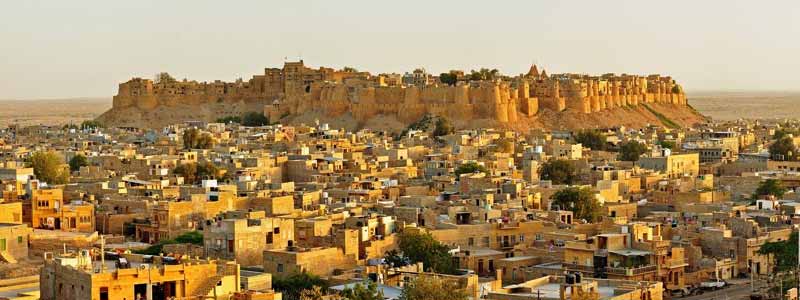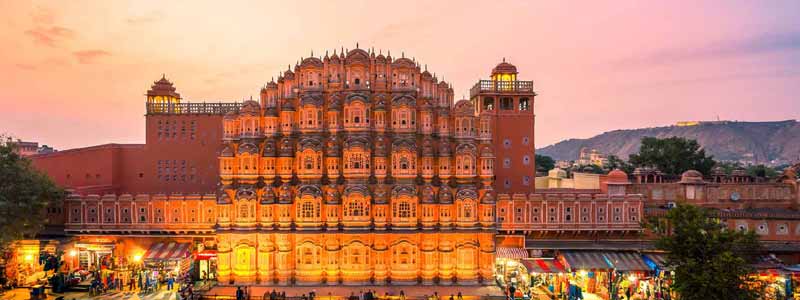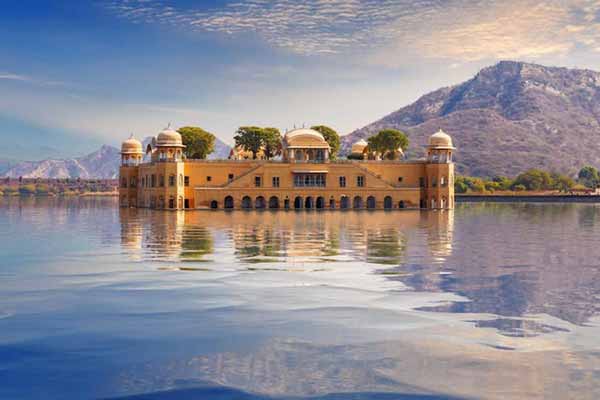Top 14 Places To Visit In Rajasthan is thought about, forts, colors, camels, temples and markets come to mind. But that’s a mere glimpse of the royal state. If you wish to explore it and have a look at its multicolored facets, you should visit the flashy cities of this princely state. It is one among the most-visited states in India as tourists from all around the globe flock this city to experience the royalty and diversity of Rajasthan Tourism. Not one or two but this state boasts of multiple attractions, which cater to the needs of all types of globetrotters.
In Rajasthan, one can find various religious sites, beautiful vistas, hill-placed forts, exciting adventurous treats, blooming lakes, friendly people and a wide variety of flora and fauna. To catch a glimpse of all this, you need to plan a tour to Rajasthan. Although Rajasthan is a huge state with multiple tourist destinations, the most sought-after ones include Jaipur, Jodhpur, Jaisalmer, Udaipur, Mount Abu, Ajmer, Bharatpur, Bikaner and Kota. explore the major tourist attractions of these picturesque cities and you won’t be disappointed.

Jaisalmer: All that glows are from here
The city of Jaisalmer has another name, the ‘Golden city’. It is located at the heart of the Thar Desert. The city is full of luxuriant forts, beautiful palaces and tranquil temples. Jaisalmer city is famous for its rich culture and age-old traditions. It has been named after the Great Maharaja Jaisal Singh. The other highlight of the city is the sand-dunes, which are eye-catching. Jaisalmer tops as Rajasthan’s must-visit cities, attracting travellers from all over the world. Every year, the city hosts the gala Desert Festival, showcasing Rajasthani art forms and folklore Rajasthan Budget Tours.
Nearest Airport: Jodhpur Aiport
Nearest Railway Station: Jaisalmer Railway station

Jaipur: The fantastic fort city
The city of Jaipur is also called as the ‘Pink City’. It is the capital city of the Rajasthan state. The Great Maharaja Sawai Jai Singh built the city in the 18th century. The city houses many historic monuments and heritage buildings. The state is well-linked to different parts of the country. In conclusion, The ever-charming pink city is surely not to miss if you are a history lover. The streets of the city are very vibrant and buzzing. Never miss the bazaars when you are here.
Nearest Airport: Sanganer Airport
Nearest Railway Station: Jaipur Junction Railway station
Jodhpur: For a royal experience
The royal city of Jodhpur was the yesteryear capital of the Mewar state. The city has stunning forts, temples and palaces. This royal city lures several travellers from the world. Jodhpur also has as another name. It called the ‘Blue City’. Wondering why? Near the Mehrangarh Fort, there are several beautiful blue houses and hence the name. The Jodhpur city can cast a spell of magic on you, once you step in! Rajasthan Special Interest.
Nearest Airport: Jodhpur airport
Nearest Railway Station: Jodhpur JunctionRailway station
Udaipur: The city of Lakes
Amongst the other best cities, Udaipur is a little special. Fondly called as the City of Lakes, the cities beauty is heart-stopping. The magnificent city was also the yesteryear capital of the Mewar Kingdom. When you are in the city, you can enjoy visiting several attractions like the City Palace, Jagdish temple, Lake Palace. If you are planning to visit the city, choose to travel in winters.
Nearest Airport: Maharana Pratap Airport
Nearest Railway Station: Udaipur Railway station
Mt.Abu: The Rajasthani Hill station
Mt. Abu is the only hill station of the Rajasthani state. Hence, it’s more than special. It is located in the Aravalli ranges lining the border of Rajasthan. It is the fondest attraction in the state because it’s the best escapade from the city buzz. If you want to experience the cool climate of Rajasthan, head to Mt. Abu and rejuvenate yourselves. Mt. Abu is indeed a must when it comes to places to visit in Rajasthan
Nearest Airport: Udaipur Aiport
Nearest Railway Station: Abu road Railway station
Pushkar: Colours Colours everywhere
One of the most famous places to visit in the Rajasthan is Pushkar. The city hosts the colourful Puskar camel fair. Millions of people rush to the city to witness the riot of colours. The Pushkar city also has the Brahma temple, which also brings in a lot of devotees. The other special event in the city is the Pushkar lake evening aarti. Being a popular Hindu pilgrimage site, the Pushkar aarti happens in a grand manner. Get your cameras ready to photograph this beautiful event.
Nearest Airport: Sanganer Airport
Nearest Railway Station: Ajmer Junction Railway station
Bundi: Visit a Boari
At about 120 Km from the Jaipur city, is the less explored City of Bundi. Being the origin and native place of the tribe Bunda Meena, the city has a famous past. With beautifully designed forts and buildings, the city offers stunning sights. The city is famous for Boaris or step wells. Boari is an ancient well-like structure to store water. When you are Bundi, never miss photographing a Boari.
Nearest Airport: Sanganer Airport
Nearest Railway Station: Bundi Railway station
Bikaner: To more temples and forts
The next beautiful city on the curated list is Bikaner. This city is popular for its Camel Festival. Several people all over the world, head to Bikaner, to witness this gala festival. The Camel festival takes place in the month of January and February. Above all, the City also houses the most famous sweet stall. It is called the Bikanervala and it sells many yummy sweets and snacks. Do not miss the sweet shop, when in Bikaner.
Nearest Airport: Jodhpur airport
Nearest Railway Station: Bikaner Junction Railway station
Ajmer: Visit the Dargah Sharif
Ajmer is another important city in Rajasthan. The must-visit in the city is the Dargah Sharif. This Dargah houses the shrine of the great Sufi saint, Moinuddin Chishti. Being the most popular place of worship in Rajasthan, Ajmer pulls in a lot of devotees to get blessings from the Dargah Top 14 Places To Visit In Rajasthan.
Nearest Airport: Sanganer Airport
Nearest Railway Station: Ajmer Junction Railway station
Bharatpur: Sheer beauty and nothing else
Amongst the popular cities in the state of Rajasthan, Bharatpur has carved its own place. This magnificent city is located 600 ft above sea level. It is fondly called ‘The Eastern Gateway to Rajasthan’. Bharatpur also houses the Keoladeo National Park. Visit the national park and say Hello to the wildlife of Rajasthan. This city is a must-visit in Rajasthan if you are a wildlife lover Top 14 Places To Visit In Rajasthan.
Nearest Airport: Delhi International Aiport
Nearest Railway Station: Bharatpur Railway station
Alwar: For History lovers
The Alwar city was founded by Raja Pratap Singh in 1770. If you are curious to visit the Bhangarh fort in Rajasthan, then Alwar is the place to be. Other than this, the city is also known for its magnificent buildings. Rajputana history has a lot of real happenings based in Alwar. Hence amongst the most visited cities in Rajasthan, Alwar is exclusively for the History lovers.
Nearest Airport: Sanganer Aiport
Nearest Railway Station: Alwar Junction
Kumbhalgarh
The Kumbhalgarh Fort is a fortress located in the Rajsamand district of Rajasthan, India. The fort is situated 82 km from Udaipur and is built on the Aravalli Range. The fort is a UNESCO World Heritage Site. The fort is also called the “Second Gibraltar of India”. The fort is said to be the birthplace of Maharana Pratap, the great king of Mewar. The Kumbhalgarh Fort was built in the 15th century by Rana Kumbha. The fort is said to be the most impregnable fort in India. The fort is surrounded by a wall that is 36 km long Top 14 Places To Visit In Rajasthan.
The wall is said to be the second longest wall in the world after the Great Wall of China. The wall has seven gates. The fort has a number of palaces, temples and water tanks. The Kumbhalgarh Fort is a popular tourist destination. The fort is home to a number of tourist attractions including the Kumbhalgarh Wildlife Sanctuary, the Kumbhalgarh Fort, the Badal Mahal Palace, the Kumbhalgarh Fort Museum and the Kumbhalgarh Temple.
Mandawa
Mandawa, part of the Shekhawati region, came into being in 1756, when Nawal Singh built the fort that has now been turned into the hotel called Castle Mandawa. But it became a full-fledged town only after Nawal Singh’s two grandsons decided to make it their home at the close of the 18th century. A magnificent heritage town considered to be one of the most aged cities located in Rajasthan, Mandawa’s beauty is at its height!
Engage in the royalty lying in the numerous Havelis and the majestic forts of Mandawa that you are free to experience because they have now been transformed into heritage hotels, still embodying the charm that has been hailing since the ancient days. The vivid art as well as the rich heritage carried by this ravishing city are there to let the travellers have a pleasant experience during their tour here.
Kota
Kota is the third largest city in the state of Rajasthan and is one of the popular tourist destinations. Situated on the banks of the Chambal River, the city of Kota is famous for its distinctive style of paintings, palaces, museums, and places of worship. The city is known for gold jewellery, Doria sarees, silk sarees and the famous Kota stone.
The history of Kota dates back to the 12th century when Rao Deva conquered the territory and founded Hadoti. The independent Rajput state of Kota was carved out of Bundi in 1631. The kingdom of Kota had a turbulent history as it was raided by various Mughal rulers, Maharajas of Jaipur and even the Maratha warlords. The city of Kota is well known all over the world for its architectural splendour comprising beautiful palaces, temples and museums which exhibit the grandeur of the foregone era Top 14 Places To Visit In Rajasthan.
